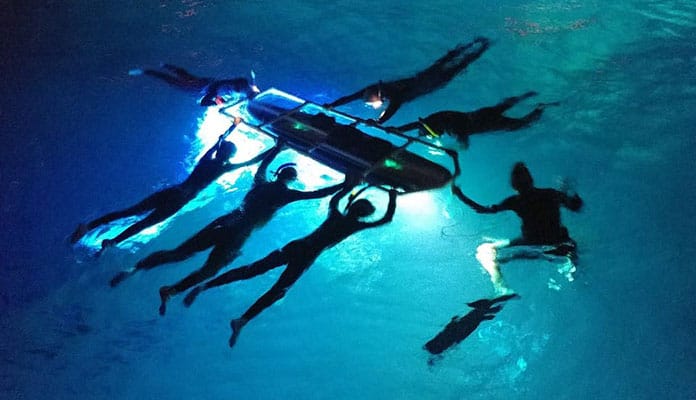
Snorkeling at night is a completely different experience than snorkeling during the day. Different fish are out than those found in the day and some even hunt during the night. Coral reefs become more active at night with shrimp and plankton swim in bunches. If you are in the right place at the right time you may even be lucky enough to see some bioluminescence (a special type of algae that lights up like a glow stick at night).
With that being said, there are some things you need to be aware of. Swimming at night has some risk associated with it since you are swimming when there is no lifeguard on duty and it would be hard to spot you if you run into trouble.
Preparing for Snorkeling at Night
There are a few things you need to do to get ready for your night dive. Always snorkel with a buddy no matter if it’s day or night. You should also choose a location that both of you have dived in the light of day. This way you will know your way around and your entry points in case of emergency. When driving at night you should also tell someone where you are going to be, much like long hikes. This should include when you are expecting to be done and what to do in case of an emergency.
Pro tip: Choose clear nights with as little clouds as possible. This will ensure you have the maximum amount of moonlight as possible.
You should also check your gear in a well-lit area. This includes ensuring your mask won’t fog and checking that you have everything you will need. Understanding the tides will also help keep you safe during your dive. Check the local tide chart before heading to your spot.
Understanding Your Equipment
You will want to be familiar with your gear. If you just got a new piece of equipment takes it out for a few dives during the day to get used to it before diving at night. Your list of gear will also be a little different than for a day dive since you and your buddy will both need an underwater light.
Depending on the location of your dive you may want to wear a skin shirt or even a light wetsuit to keep you warm and protect you from encounters with the sea life. A whistle should also be a piece of gear you bring.
You might also like: Snorkeling With A Mustache Or A Beard
Communication
As you are heading out to the ocean in the dark, your main source of communication with your buddy will be through light. Communicating with the shore, or the boat will be a lot more challenging. Your best bet is to always stay close to your buddy. Hand signals will likely not work as well but can still be attempted. When doing this be sure to shine your light towards your body and use one-handed signals to indicate ok.
Alternatively, you can draw a large symbol “O” using your light to indicate to a boat or your buddy that you are ok. If you are wanting to show your buddy something underwater, simply shine your light across their beam of light being careful not to shine directly in their face.
Safety
As you are in a more vulnerable situation when snorkeling at night it is important to remember a few safety rules. First and foremost you must always swim with a buddy when night swimming. You will also want to pack along a light, whistle and be sure to wear a life vest. The rapid succession of whistle blows indicates danger and is a call to rescue. The rapid back and forth of light signals are having the same effect.
Globo Surf Overview
For so many people, the end of their snorkeling experience comes with the setting sun. While this is a common thought, it does limit your experiences by only exposing you to some of the beauty the underwater world offers. The reef comes alive at nightfall with marine life being incredibly active. Shrimp, crabs, octopus all come from hiding which will allow you to see a different array of underwater life.
Snorkel Skill Guides:

